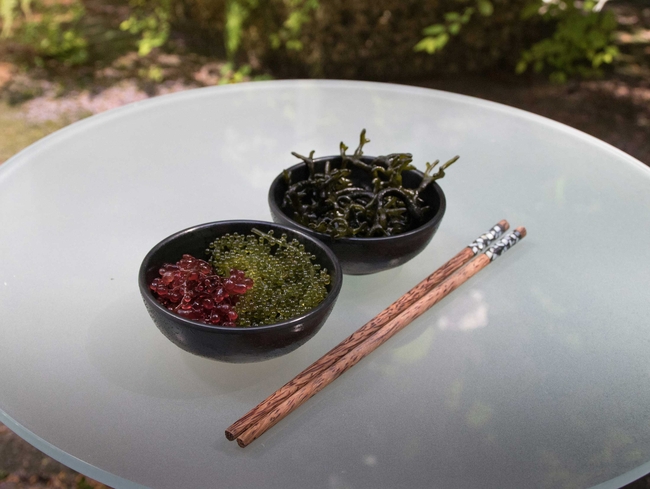Taste of the ocean: a comparison of five edible seaweeds
Researchers at the Leibniz Centre for Tropical Marine Research (ZMT) and the University of Bremen have studied the nutritional value of five edible seaweed species, including some lesser-known algae, and examined their potential for sustainable nutrition. The study, published in the journal Discover Food, shows that the analysed species are rich in polyunsaturated fatty acids and have strong antioxidant properties as well as high protein and mineral contents.
The scientists – among them Beatrice Brix da Costa, a doctoral student at the University of Bremen and ZMT – selected five macroalgal species for their analyses: the green algal species Caulerpa cylindracea, Caulerpa racemosa, Caulerpa lentillifera and Codium taylorii as well as the red alga Botryocladia pseudodichotoma. The algae Caulerpa cylindracea is an invasive species in the Mediterranean Sea and has spread rapidly there since the 1990s.
The researchers used various methods to determine the composition of the seaweeds and their moisture, carbohydrate, protein, fatty acid, pigment, mineral and antioxidant content.
All of the species studied contained high amounts of polyunsaturated fatty acids, in particular the omega-3 fatty acids alpha-linolenic acid (ALA) in the green algae and eicosapentaenoic acid (EPA) in the red alga.
Mineral analyses showed that sodium, calcium, magnesium and potassium were the most prevalent macronutrients – nutrients that are important for bones, muscles and general human metabolism.
The green algae (Caulerpa cylindracea, Caulerpa lentillifera, Caulerpa racemosa and Codium taylorii) in particular exhibited strong antioxidant properties. Codium taylorii was also rich in protein. The red alga Botryocladia pseudodichotoma had a high magnesium and potassium content.
“Due to their biochemical composition, the macroalgae that we studied are ideal as sustainable, nutrient-rich foods, natural sources of antioxidants or as a basis for dietary supplements,” reports Beatrice Brix da Costa, first author of the study. “In Southeast Asia and Fiji, the sea grapes Caulerpa lentillifera and Caulerpa racemosa are already established as foods and delicacies,“ she says.
However, no single species can cover all the important nutrients, and dietary diversity remains crucial, the researcher argues.
Algae can contribute to food security
“According to UN figures, the world population will grow to more than 8.5 billion people by 2030, while agriculture is coming under pressure from land loss and climate change,” explains Andreas Kunzmann, head of the Experimental Aquaculture research group at ZMT. “Sustainable aquaculture of marine algae or the use of invasive species can provide an additional resource-saving food source and reduce dependence on conventional agriculture. We are investigating this topic together with other Leibniz Institutes in the food4future project. For example, we have discovered how to increase the content of valuable ingredients, including antioxidants, in Caulerpa lentillifera,” Kunzmann says.
“The results of our current study are a snapshot,” emphasises Karin Springer from the Marine Botany working group at the University of Bremen. “The biochemical composition of algae varies significantly – both between and within species – and depends on various factors such as light, temperature and the availability of nutrients in the water. This must be taken into account in algae aquaculture.”
“We have shown that yet untapped algae species are not only ecologically valuable, but also have an impressive nutritional profile,” concludes Beatrice Brix da Costa. “With targeted algae cultivation and suitable utilisation concepts, new avenues for sustainable nutrition can be opened up – even here in Europe.”
About the food4future (f4f) project:
Against the backdrop of a growing global population and the scarcity of key resources such as productive land, water and mineral fertilisers, global food security faces major challenges. To what extent can the management of our oceans contribute to solving these problems? In the joint project food4future (f4f), ZMT’s research group ‘Experimental Aquaculture’ is working on this issue and investigating opportunities for sustainable aquaculture and the possibilities of using unusual but nutrient-rich food from the sea – such as jellyfish, sea cucumbers or macroalgae. More than nine partner institutions from science and industry are cooperating closely in the project. The project is funded by the Federal Ministry of Research, Technology and Space (BMFTR) and coordinated by the Leibniz Institute of Vegetable and Ornamental Crops (IGZ). ZMT is responsible for a sub-project in this consortium.
Publication:
Brix da Costa B, Kunzmann A, Springer K (2025) Comparative Analysis of the Nutritional Profiles of Five Edible Macroalgae for Sustainable Food Production. Discover Food 5:287. DOI: 10.1007/s44187-025-00603-3, https://doi.org/10.1007/s44187-025-00603-3





